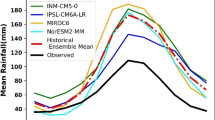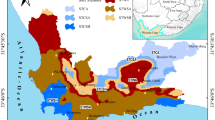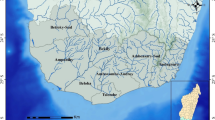Abstract
An alteration of rainfall variability and changes in rainfall driven extremes have been noticed across the globe with rising earth temperature. Such changes will undoubtedly be more devastating for agriculture-based developing countries. This study evaluated possible changes in rainfall and droughts in Bangladesh, a high climate change susceptible country, due to 1.5 and 2 °C temperature rise scenarios. Projections of global climate models (GCMs) of the coupled model intercomparison project phase 6 (CMIP6) for two shared socioeconomic pathway (SSP) scenarios, SSP-119 and SSP-126, were used for this purpose. The results showed an increase in annual rainfall over Bangladesh for both scenarios. However, the changes in rainfall variability would cause a drastic change in the drought pattern. Overall, drought frequency may decrease in the drought-prone western region up to -50% and increase in the east up to 50 to 70%, making droughts more homogeneously distributed over the country. However, a higher increase in the east than a decrease in the west for SSP119 indicates a possible shift in the country’s drought-prone region. The drought scenarios for SSP119 and SSP126 revealed that a 0.5 °C further rise in temperature might cause an increase in extreme drought frequency by 30% in the central-eastern region. Bangladesh should take effective drought mitigation measures to sustain its agricultural development.










Similar content being viewed by others
Data availability
All data used in the study are available in the public domain. Those are also available for sharing on request to the corresponding author.
Code availability
The codes used for the processing of data can be provided on request to the corresponding author.
References
Aadhar S, Mishra V (2020) On the projected decline in droughts over South Asia in CMIP6 multimodel ensemble. J Geophys Res: Atmos 125(20): e2020JD033587
Ahmed K, Shahid S, Wang X, Nawaz N, Khan N (2019) Evaluation of gridded precipitation datasets over arid regions of Pakistan. Water 11(2):210
Ahmed K, Sachindra DA, Shahid S, Iqbal Z, Nawaz N, Khan N (2020) Multi-model ensemble predictions of precipitation and temperature using machine learning algorithms. Atmospheric Research 236: 104806
Alamgir M, Khan N, Shahid S, Yaseen ZM, Dewan A, Hassan Q, Rasheed B (2020) Evaluating severity–area–frequency (SAF) of seasonal droughts in Bangladesh under climate change scenarios. Stochastic Environ Res Risk Assess 34(2):447–464. https://doi.org/10.1007/s00477-020-01768-2
Alamgir M, Ahmed K, Homsi R, Dewan A, Wang JJ, Shahid S (2019) Downscaling and projection of spatiotemporal changes in temperature of Bangladesh. Earth Syst Environ 3(3):381–398
Almazroui M, Saeed F, Islam MN, Ismail M, Klutse NAB, Siddiqui MH (2020). Projected change in temperature and precipitation over Africa from CMIP6. Earth Syst Environ :1–21.
Boucher O, Jerome S, Albright A, Aumont O, Balkanski Y, Bastrikov V, Bekki S, Bonnet R, Bony S, Bopp L, Braconnot P, Brockmann P, Cadule P, Caubel A, Cheruy F, Codron F, Cozic A, Cugnet D, D’Andrea F, Vuichard N (2020) Presentation and evaluation of the IPSL‐CM6A‐LR climate model. J Adv Model Earth Syst 12. https://doi.org/10.1029/2019MS002010
Caesar J, Janes T, Lindsay A, Bhaskaran B (2015) Temperature and precipitation projections over Bangladesh and the upstream Ganges, Brahmaputra and Meghna systems. Environ Sci Process Impacts 17(6):1047–1056
Gusain, A., Ghosh, S. & Karmakar, S. 2020. Added value of CMIP6 over CMIP5 models in simulating Indian summer monsoon rainfall. Atmospheric Research, 232, 104680
Held I, Guo H, Adcroft A, Dunne J, Horowitz L, Krasting J, Shevliakova E, Winton M, Zhao M, Bushuk M, Wittenberg A, Wyman B, Xiang B, Zhang R, Anderson W, Balaji V, Donner L, Dunne K, Durachta J, Zadeh N (2019) Structure and performance of GFDL’s CM4.0 climate model. J Adv Model Earth Syst 11:3691–3727. https://doi.org/10.1029/2019MS001829
Hoegh-Guldberg O, Jacob D, Taylor M, Bindi M, Brown S, Camilloni I, Diedhiou A, Djalante R, Ebi K, Engelbrecht F, Zhou G, Joel G, Hijioka Y, Mehrotra S, Payne A, Seneviratne S, Thomas A, Warren R, Halim S, Guillén Bolaños T (2018) Chapter 3: Impacts of 1.5°C global warming on natural and human systems. In:V. Masson-Delmotte, P. Zhai, H. O. Pörtner, D. Roberts, J. Skea, P.R. Shukla, A. Pirani, W. Moufouma-Okia, C. Péan, R. Pidcock, S. Connors, J. B. R. Matthews, Y. Chen, X. Zhou, M. I. Gomis, E. Lonnoy, T. Maycock, M. Tignor, T. Waterfield (eds.) Global Warming of 1.5 °C. An IPCC special report on the impacts of global warming of 1.5 °C above preindustrial levels and related global greenhouse gas emission pathways pathways, in the context of strengthening the global response to the threat of climate change, sustainable development, and efforts to eradicate poverty. pp. 175–311
Hulme M (2016) 1.5 °C and climate research after the Paris Agreement. Nat Clim Chang 2386(3): 222–224
Islam MA, Ahmed A, Munir MM, Khandakar ZZ (2021) Verification of APHRODITE Precipitation Data Set in Bangladesh. J Eng Sci 12(1):51–56
Islam MA, Laz OU (2018) Assessment of gauge-based APHRODITE precipitation estimates over Bangladesh. Japan Geoscience Union Meeting 2018, May20–24 Chiba, Japan. Paper No. AAS05–09
Jain S, Mishra SK, Salunke P, Sahany S (2019) Importance of the resolution of surface topography vis-à-vis atmospheric and surface processes in the simulation of the climate of Himalaya-Tibet highland. Clim Dyn 52:4735–4748
James R, Washington R, Schleussner C-F, Rogelj J, Conway D (2017) Characterizing half-a-degree difference: a review of methods for identifying regional climate responses to global warming targets. Wires Clim Chang. https://doi.org/10.1002/wcc.457
Jerin JN, Islam HT, Islam ARMT, Shahid S, Hu Z, Badhan MA, ..., Elbeltagi A (2021) Spatiotemporal trends in reference evapotranspiration and its driving factors in Bangladesh. Theoretical Appl Climatol 144(1): 793-808
Kamruzzaman M, Jang M-W, Cho J, Hwang S (2019) (2019) Future changes in precipitation and drought characteristics over Bangladesh under CMIP5 climatological projections. Water 11:2219. https://doi.org/10.3390/w11112219
Kamruzzaman, M., Shahid, S., Islam, A. T., Hwang, S., Cho, J., Zaman, M. A. U., Ahmed, M., Rahman M. M., & Hossain, M. B. (2021). Comparison of CMIP6 and CMIP5 model performance in simulating historical precipitation and temperature in Bangladesh: A preliminary study. Theor Appl Climatol 145(1-2). https://doi.org/10.1007/s00704-021-03691-0
Khan N, Shahid S, Ismail T, Ahmed K, Nawaz N (2019) Trends in heat wave related indices in Pakistan. Stoch Env Res Risk Assess 33(1):287–302
Khan JU, Islam AKMS, Das MK et al (2020a) (2020b) Future changes in meteorological drought characteristics over Bangladesh projected by the CMIP5 multi-model ensemble. Clim Change 162:667–685. https://doi.org/10.1007/s10584-020-02832-0
Khan N, Shahid S, Chung E-S, Behlil F, Darwish M (2020a) Spatiotemporal changes in precipitation extremes in the arid province of Pakistan with removal of the influence of natural climate variability. Theoretical Appl Climatol 142. https://doi.org/10.1007/s00704-020-03389-9
Long SM, Li G (2021) Model uncertainty in the projected Indian summer monsoon precipitation change under low-emission scenarios. Atmosphere 12(2):248
Mckee TB, Doesken NJ, Kleist J (1993). The relationship of drought frequency and duration to time scales. In Eighth Conference on Applied Climatology
Mishra V, Bhatia U, Tiwari AD (2020) Bias-corrected climate projections for South Asia from coupled model intercomparison project-6. Scientific Data 7(1):1–13
Mitchell D, James R, Forster PM, Betts RA, Shiogama H, Allen M (2016) Realizing the impacts of a 1.5°C warmer world. Nat Clim Chang 2576(8): 735–737
Mohsenipour M, Shahid S, Chung E-S, Wang X (2018) Changing pattern of droughts during cropping seasons of Bangladesh. Water Resour Manag 32. https://doi.org/10.1007/s11269-017-1890-4
Mondal MS, Nowreen S, Sakib MN (2020) Scale-dependent reliability of projected rainfalls over Bangladesh with the PRECIS model. In Climate (Vol. 8, Issue 2). https://doi.org/10.3390/cli8020020
Mondal SK, Huang J, Wang Y, Su B, Zhai J, Tao H, ..., Jiang T (2021) Doubling of the population exposed to drought over South Asia: CMIP6 multi-model-based analysis. Sci Total Environ 771: 145186
Mortuza MR, Moges E, Demissie Y, Li H-Y (2019) Historical and future drought in Bangladesh using copula-based bivariate regional frequency analysis. Theoret Appl Climatol 135(3):855–871. https://doi.org/10.1007/s00704-018-2407-7
Narsey SY, Brown JR, Colman RA, Delage F, Power SB, Moise AF, Zhang H (2020) Climate change projections for the Australian monsoon from CMIP6 models. Geophys Res Lett 47(13):e2019GL086816
Nashwan MS, Shahid S, Wang X (2019) Uncertainty in estimated trends using gridded rainfall data: a case study of Bangladesh. Water 11(2):349
Nie S, Fu S, Cao W, Jia X (2020) Comparison of monthly air and land surface temperature extremes simulated using CMIP5 and CMIP6 versions of the Beijing Climate Center climate model. Theoretical Appl Climatol 140(1):487–502
O'Neill BC, Tebaldi C, Vuuren DPV, Eyring V, Friedlingstein P, Hurtt G, Sanderson BM (2016) The scenario model intercomparison project (ScenarioMIP) for CMIP6. Geosci Model Dev 9(9):3461–3482
Pour SH, Shahid S, Chung ES, Wang XJ (2018) Model output statistics downscaling using support vector machine for the projection of spatial and temporal changes in rainfall of Bangladesh. Atmos Res 213:149–162. https://doi.org/10.1016/j.atmosres.2018.06.006
Rashid HE (1991) Geography of Bangladesh (Second). University Press, Dhaka, Bangladesh
Rivera JA, Arnould G (2020). Evaluation of the ability of CMIP6 models to simulate precipitation over Southwestern South America: Climatic features and long-term trends (1901–2014). Atmos Res 241:104953. https://doi.org/10.1016/j.atmosres.2020.104953
Schleussner CF, Lissner TK, Fischer EM, Wohland J, Perrette M, Golly A, Rogelj J, Childers K, Schewe J, Frieler K, Mengel M, Hare W, Schaeffer M (2016) Differential climate impacts for policy-relevant limits to global warming: the case of 1.5º C and 2ºC. Earth System Dynamics:7(2):327 https://doi.org/10.5194/esd-7-327-2016
Shahid S (2008) Spatial and temporal characteristics of droughts in the western part of Bangladesh. Hydrological Processes: an International Journal 22(13):2235–2247
Shahid S, Behrawan H (2008) Drought risk assessment in the western part of Bangladesh. Nat Hazards 46(3):391–413
Swart NC, Cole JNS, Kharin VV, Lazare M, Scinocca JF, Gillett NP, Anstey J, Arora V, Christian JR, Hanna S, Jiao Y, Lee WG, Majaess F, Saenko OA, Seiler C, Seinen C, Shao A, Sigmond M, Solheim L, …, Winter B (2019) The Canadian Earth System Model version 5 (CanESM5.0.3). Geosci Model Dev, 12(11):4823–4873. https://doi.org/10.5194/gmd-12-4823-2019
Tatebe H, Ogura T, Nitta T, Komuro Y, Ogochi K, Takemura T, Sudo K, Sekiguchi M, Abe M, Saito F, Chikira M, Watanabe S, Mori M, Hirota N, Kawatani Y, Mochizuki T, Yoshimura K, Takata K, O'ishi, R., & Kimoto, M. (2019) Description and basic evaluation of simulated mean state, internal variability, and climate sensitivity in MIROC6. Geoscientific Model Development 12:2727–2765. https://doi.org/10.5194/gmd-12-2727-2019
Veronika E, Bony S, Meehl GA, Senior CA, Stevens B, Stouffer RJ, Taylor KE (2016) Overview of the Coupled Model Intercomparison Project Phase 6 (CMIP6) experimental design and organization. Geosci Model Dev 9(5):1937–1958
Wright DB, Knutson TR, Smith JA (2015) Regional climate model projections of rainfall from U.S. landfalling tropical cyclones. Climate Dyn 45(11):3365–3379. https://doi.org/10.1007/s00382-015-2544-y
Wyser K, Noije T, Yang S, Hardenberg J, O’Donnell D, Döscher R (2019) On the increased climate sensitivity in the EC-Earth model from CMIP5 to CMIP6. https://doi.org/10.5194/gmd-2019-282
Xu C, McDowell NG, Fisher RA, Wei L, Sevanto S, Christoffersen BO, Weng E, Middleton RS (2019) Increasing impacts of extreme droughts on vegetation productivity under climate change. Nat Clim Chang 9(12):948–953. https://doi.org/10.1038/s41558-019-0630-6
Yukimoto S, Kawai H, Koshiro T, Oshima N, Yoshida K, Urakawa S, Tsujino H, Deushi M, Tanaka T, Hosaka M, Yabu S, Yoshimura H, Shindo E, Mizuta R, Obata A, Adachi Y, Ishii M (2019) The meteorological research institute earth system model version 2.0, MRI-ESM2.0: description and basic evaluation of the physical component. J Meteorol Soc Japan. Ser. II, 97. https://doi.org/10.2151/jmsj.2019-051
Zamani Y, Monfared SAH, Hamidianpour M (2020) A comparison of CMIP6 and CMIP5 projections for precipitation to observational data: the case of Northeastern Iran. Theoretical Appl Climatol 142(3):1613–1623
Zhai J, Mondal SK, Fisher T, Wang Y, Su B, Huang J, Tao H, Wang G, Ullah W, Uddin MJ (2020) Future drought characteristics through a multi-model ensemble from CMIP6 over South Asia. Atmos Res 246:105111
Acknowledgements
The authors are grateful to the World Climate Research Program (WCRP) for providing CMIP6 climate simulation data through the web portal. The authors are also grateful to the National Center for Atmospheric Research (NCAR) for providing Asian Precipitation—Highly-Resolved Observational Data Integration Towards Evaluation (APHRODITE) precipitation data through their website.
Author information
Authors and Affiliations
Contributions
All the authors contributed to conceptualize and design the study. Data were gathered by Farhad Hossain; the modelling was done by Maksud Kamal and Shamsuddin Shahid; an initial draft of the paper was prepared by Maksud Kamal and Farhad Hossain; the article was repeatedly revised to generate the final version by Maksud Kamal and Shamsuddin Shahid.
Corresponding author
Ethics declarations
Ethics approval
Not applicable.
Consent to participate
Not applicable.
Consent for publication
All the authors consented to publish the paper.
Conflict of interest
The authors declare no competing interests.
Additional information
Publisher's note
Springer Nature remains neutral with regard to jurisdictional claims in published maps and institutional affiliations.
Rights and permissions
About this article
Cite this article
Kamal, A.S.M.M., Hossain, F. & Shahid, S. Spatiotemporal changes in rainfall and droughts of Bangladesh for1.5 and 2 °C temperature rise scenarios of CMIP6 models. Theor Appl Climatol 146, 527–542 (2021). https://doi.org/10.1007/s00704-021-03735-5
Received:
Accepted:
Published:
Issue Date:
DOI: https://doi.org/10.1007/s00704-021-03735-5




